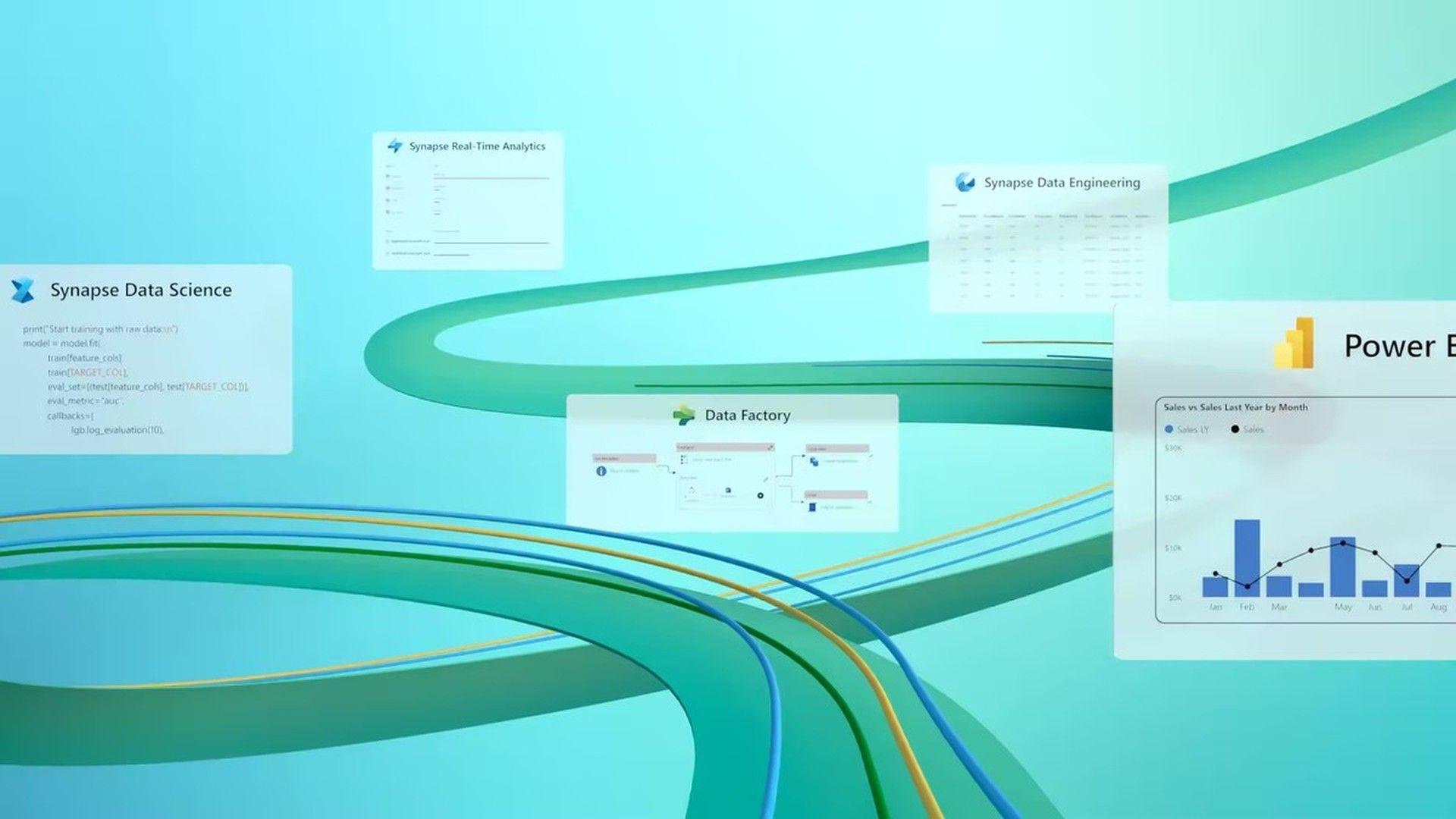Microsoft has made good on its promise to deliver a simplified and more efficient Microsoft Fabric price model for its end-to-end platform designed for analytics and data workloads. Based on the total compute and storage utilized by customers, the company’s new pricing structure eliminates the need for separate payment for compute and storage buckets associated with each of Microsoft’s multiple services.
This strategic move lights up the competition with major rivals like Google and Amazon, who offer similar analytics and data products but charge customers multiple times for various discrete tools employed on their respective cloud platforms.
Microsoft Fabric price is about to be announced
Although we do not have official Microsoft Fabric price data, which will be shared tomorrow, VentureBeat shared the average prices that Microsoft will charge for this service, and it is as follows:
| Stock-Keeping Units (SKU) | Capacity Unit (CU) | Pay-as-you-go at US West 2 (hourly) | Pay-as-you-go at US West 2 (monthly) |
| F 2 | 2 | $0.36 | $262.80 |
| F 4 | 4 | $0.72 | $525.60 |
| F 8 | 8 | $1.44 | $1,1051.20 |
| F 16 | 16 | $2.88 | $2,102.40 |
| F 32 | 32 | $5.76 | $4,204.80 |
| F 64 | 64 | $11.52 | $8,409.60 |
| F 128 | 128 | $23.04 | $16,819,2 |
| F 256 | 256 | $46.08 | $33,638.40 |
| F 512 | 512 | $92.16 | $67,276.80 |
| F 1024 | 1024 | $184.32 | $134,553.60 |
| F 2048 | 2048 | $368.64 | $269,107.20 |
As you can see in the table, the Microsoft Fabric price is shaped to deliver the service your company needs with minimum expenditure by choosing a way that you will pay as much as you use according to the quantity of SKU and CU you will use and not on a fixed price of the service you receive.
Especially for small businesses, we think that this kind of payment plan is much more accurate and a good step to ensure equality in the market because similar services in the market are not very accessible, especially on a low budget.
Microsoft’s unified pricing model for the Fabric suite marks a significant advancement in the analytics and data market. With this model, customers will be billed based on the total computing and storage they utilize.
This eliminates the complexities and costs associated with separate billing for individual services. By streamlining the pricing process, Microsoft is positioning itself as a formidable competitor to industry leaders such as Google and Amazon, who have repeatedly charged customers for different tools employed within their cloud ecosystems.
It is a fact that the Microsoft Fabric price will differentiate it from other tools in the industry because, normally, when you buy such services, you are billed for several services that you do not really use. The pricing Microsoft offers your business is a bit unusual.
All you need in one place
So is the Microsoft Fabric price the tech giant’s only plan to stay ahead of the data game? Of course not!
Microsoft Fabric suite integration brings together six different tools into a unified experience and data architecture, including:
- Azure Data Factory
- Azure Synapse Analytics
- Data engineering
- Data warehouse
- Data science
- Real-time analytics
- Power BI
This consolidation within the Microsoft Fabric price you will pay allows engineers and developers to seamlessly extract insights from data and present them to business decision-makers.
Microsoft’s focus on integration and unification sets Fabric apart from other vendors in the market, such as Snowflake, Qlik, TIBCO, and SAS, which only offer specific components of the analytics and data stack.
This integrated approach provides customers with a comprehensive solution encompassing the entire data journey, from storage and processing to visualization and analysis.

The contribution of Power BI
The integration of Microsoft Power BI and Microsoft Fabric offers a powerful combination for organizations seeking comprehensive data analytics and insights. Together, these two solutions work in harmony, providing numerous benefits:
- Streamlined analytics workflow: Power BI’s intuitive interface and deep integration with Microsoft products seamlessly fit within the Microsoft Fabric ecosystem, enabling a cohesive analytics workflow.
- Unified data storage: Fabric’s centralized data lake, Microsoft OneLake, eliminates data silos and provides a unified storage system, simplifying data access and retrieval.
- Cost efficiency: Power BI can directly leverage data stored in OneLake, eliminating the need for separate SQL queries and reducing costs associated with data processing.
- Enhanced insights through AI: Fabric’s generative AI capabilities, such as Copilot, enhance Power BI by enabling users to use conversational language to create data flows, build machine learning models, and derive deeper insights.
- Multi-cloud support: Fabric’s support for multi-cloud environments, including shortcuts that virtualize data lake storage across different cloud providers, allows seamless incorporation of diverse data sources into Power BI for comprehensive analysis.
- Flexible data visualization: Power BI’s customizable and visually appealing charts and reports, combined with Fabric’s efficient data storage, provide a flexible and engaging data visualization experience.
- Scalability and performance: Fabric’s robust infrastructure ensures scalability and performance, supporting Power BI’s data processing requirements as organizations grow and handle larger datasets.
- Simplified data management: With Fabric’s unified architecture, organizations can provision compute and storage resources more efficiently, simplifying data management processes.
- Data accessibility: The integration allows Power BI users to easily access and retrieve data from various sources within the organization, promoting data accessibility and empowering users to derive insights.
This combination enables organizations to unlock the full potential of their data and make data-driven decisions with greater efficiency and accuracy.
Centralized data lake for all your data troubles
At the core of Microsoft Fabric lies the centralized data lake, known as Microsoft OneLake. OneLake is designed to store a single copy of data in a unified location, leveraging the open-source Apache Parquet format.
This open format allows for seamless storage and retrieval of data across different databases. By automating the integration of all Fabric workloads into OneLake, Microsoft eliminates the need for developers, analysts, and business users to create their own data silos.
This approach not only improves performance by eliminating the need for separate data warehouses but also results in substantial cost savings for customers.
Flexible compute capacity
One of the key advantages of Microsoft Fabric is its ability to optimize compute capacity across different workloads. Unused compute capacity from one workload can be utilized by another, ensuring efficient resource allocation and cost optimization. Microsoft’s commitment to innovation is evident in the addition of Copilot, Microsoft’s chatbot powered by generative AI, to the Fabric suite.
Copilot enables developers and engineers to interact in conversational language, simplifying data-related tasks such as querying, data flow creation, pipeline management, code generation, and even machine learning model development.
Moreover, Fabric supports multi-cloud capabilities through “Shortcuts,” allowing virtualization of data lake storage in Amazon S3 and Google Cloud Storage, providing customers with flexibility in choosing their preferred cloud provider.

Why should your business use Microsoft Fabric?
Microsoft Fabric offers numerous advantages for businesses that are looking to enhance their data and analytics capabilities.
Here are compelling reasons why your business should consider using Microsoft Fabric:
- Unified data platform: Microsoft Fabric provides a comprehensive end-to-end platform for data and analytics workloads. It integrates multiple tools and services, such as Azure Data Factory, Azure Synapse Analytics, and Power BI, into a unified experience and data architecture. This streamlined approach eliminates the need for separate solutions and simplifies data management.
- Simplified pricing: The Microsoft Fabric price is based on total compute and storage usage. Unlike some competitors who charge separately for each service or tool, Microsoft Fabric offers a more straightforward pricing model. This transparency helps businesses control costs and make informed decisions about resource allocation.
- Cost efficiency: With Microsoft Fabric, businesses can leverage a shared pool of compute capacity and a single storage location for all their data. This eliminates the need for creating and managing separate storage accounts for different tools, reducing costs associated with provisioning and maintenance. This is one of the most important features that make the Microsoft Fabric price even more accessible.
- Improved performance: Fabric’s centralized data lake, Microsoft OneLake, provides a unified and open architecture for data storage and retrieval. This allows for faster data access and eliminates the need for redundant SQL queries, resulting in improved performance and reduced processing time.
- Advanced analytics capabilities: Microsoft Fabric offers advanced analytics features, including generative AI capabilities like Copilot, which enable users to leverage artificial intelligence for data analysis, machine learning model creation, and data flow creation. These capabilities empower businesses to derive deeper insights and make data-driven decisions.
- Multi-cloud support: Fabric’s multi-cloud support allows businesses to seamlessly integrate data from various cloud providers, including Amazon S3 and Google storage. This flexibility enables organizations to leverage diverse data sources and work with multiple cloud platforms as per their requirements.
- Scalability and flexibility: Microsoft Fabric is designed to scale with the needs of businesses, providing flexibility to handle growing data volumes and increasing analytics workloads. The platform’s infrastructure ensures high performance and reliability, allowing businesses to process and analyze large datasets effectively.
- Streamlined workflows: Fabric’s integration with other Microsoft products, such as Power BI, creates a seamless analytics workflow. Users can easily access and analyze data stored in the centralized data lake, enabling efficient data exploration, visualization, and reporting.
- Simplified data management: Microsoft Fabric’s unified architecture and centralized data lake simplify data management processes. Businesses can eliminate data silos, provision resources more efficiently, and enable easier data sharing and collaboration across teams.
- Microsoft ecosystem integration: As part of the broader Microsoft ecosystem, Fabric integrates seamlessly with other Microsoft services and tools. This integration provides businesses with a cohesive and comprehensive solution stack, leveraging the strengths of various Microsoft offerings.
When we take the Microsoft Fabric price into account, bringing all these features together under a pay-as-you-go model is definitely a great opportunity for users.
How to try Microsoft Fabric for free
Did you like what you saw? You can try this platform that can handle all your data-related tasks without even paying the Microsoft Fabric price.
To gain access to the Fabric app, simply log in to app.fabric.microsoft.com using your Power BI account credentials. Once logged in, you can take advantage of the opportunity to sign up for a free trial directly within the app, and the best part is that no credit card information is needed.
In the event that the account manager tool within the app does not display an option to initiate the trial, it is possible that your organization’s tenant administration has disabled access to Fabric or trials. However, don’t worry, as there is still a way for you to acquire Fabric. You can proceed to purchase Fabric via the Azure portal by following the link conveniently provided within the account manager tool.

Microsoft Fabric price and its impact on competitors
The move on the Microsoft Fabric price, which offers a unified approach, poses a significant challenge to major cloud competitors like Amazon and Google, who have traditionally charged customers separately for various services.
By providing a comprehensive and integrated package of capabilities, Fabric also puts pressure on vendors that offer only specific components of the analytics and data stack. For instance, Snowflake’s reliance on proprietary data formats and limited interoperability raises questions about its ability to compete with Microsoft’s holistic solution.
Let’s see if Microsoft can once again prove why it is a leading technology company and usher in a new era of data management.






